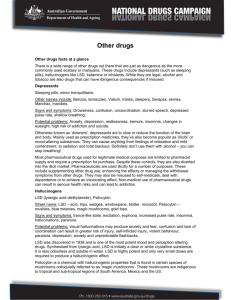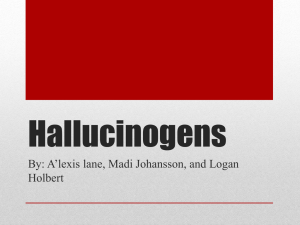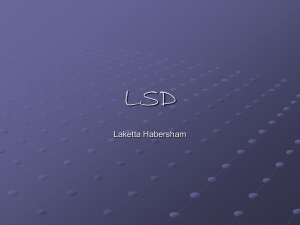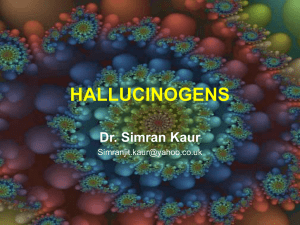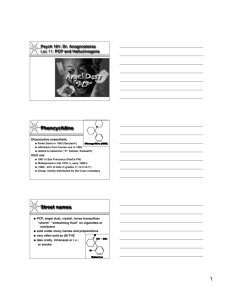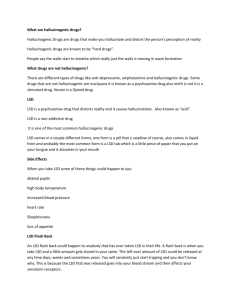Psychopharmacology - Where can my students do assignments that
advertisement
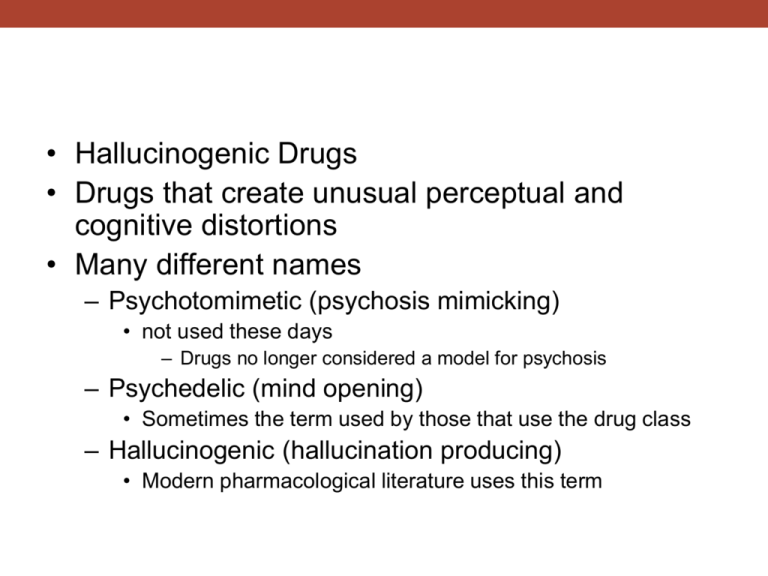
• Hallucinogenic Drugs • Drugs that create unusual perceptual and cognitive distortions • Many different names – Psychotomimetic (psychosis mimicking) • not used these days – Drugs no longer considered a model for psychosis – Psychedelic (mind opening) • Sometimes the term used by those that use the drug class – Hallucinogenic (hallucination producing) • Modern pharmacological literature uses this term • Mescaline – Obtained from the peyote cactus plant – Dried crown of the plant is know as a mescal button, or peyote button. – Buttons can be chewed raw or cooked and then eaten – It is also possible to extract the mescaline from the plant and create a relatively pure powder • Archeological evidence suggests that natives of Southwestern United States and Northern Mexico Have used for thousands of years • Native Americans used peyote for religious and healing rituals • Aldous Huxley (Brave New World) – Used mescaline and advocated use of hallucinogens – Some consider his writings about the experiences of hallucinogens to have spawned the rise of their popularity in the 1960s • “The Doors of Perception” • “Heaven and Hell” • Mescaline is not as readily available in present times as other hallucinogens Psilocybin, DMT, and 5-MeO-DMT • “Shrooms” or “Magic Mushrooms” – Numerous species of mushrooms have hallucinogenic properties – Psilocybe mushrooms • Depending on the species, users take about 1-5 g of dried mushrooms to obtain desired effects • Can be consumed raw, boiled in water to make tea, or cooked with other foods – Tends to be bitter alone • The major ingredient of mushrooms are psilocybin and the related compound psilocin – Psilocin is the actual psychoactive agent • Psilocybin is converted by enzymatic action to psilocin after ingestion • Use of hallucinogenic mushrooms probably goes as far back as peyote use – Algerian painting dated to at least 3500 B.C. • Shaman? • Notice mushrooms sprouting from entire body and held in hands • The Spaniards tried to suppress the use of mushrooms when they conquered the Aztecs in the early 1500s – They were not completely successful • The existence of hallucinogenic mushrooms was largely ignored until the 1950s and 60s • Timothy Leary lecturer at Harvard ate magic mushrooms while visiting Mexico in 1959 – Formed the Harvard Psychedelic Drug Research Program – Purpose was “to teach individuals how to self-administer psychoactive drugs in order to free their psyches without reliance upon doctors or institutions” – Gave psilocybin to students and faculty – Also experimented with LSD – Dismissed from Harvard in 1963 – Became leader in psychedelic movement DMT and 5-MeO-DMT • DMT and 5-MeO-DMT are substances found in several plants indigenous to South America • Native tribes make hallucinogenic snuffs from these plants • DMT in this country is usually sold in powdered form and taken by smoking • Synthetic analogs have been gaining popularity – Α-methyltryptramine (AMT) – 5-methoxydiisopropyltryptamine • Foxy Methoxy or Foxy LSD • LSD is a synthetic compound • Its structure is based on a family of fungal alkaloids – Alkaloids are chemical compounds containing nitrogen that have psychopharmacological effects • often found in plants and fungi LSD first synthesized in 1938 • • • Albert Hofmann Worked for a pharmaceutical company in Switzerland (Sandoz) Studying ergot – a substance produced by a parasitic fungus that can infest rye and wheat • Ergot is extremely toxic to humans – A core structure of the alkaloids contained in ergot is lysergic acid • Hofmann combined lysergic acid with other compounds in an attempt to generate drugs to stimulate the circulatory system LSD-25 (LSD) • The 25th compound synthesized was d-lysergic acid diethylamide – LSD-25 • Hoffman accidentally ingested some and had strange sensations • Later he took a small amount on purpose – Had powerful effects • Sandoz marketed the drug in 1947 – Delysid • To help neurotic patients uncover repressed thoughts and feelings • In the 50s and 60s there were a lot of studies published on the effects of LSD – The fact that LSD altered serotonergic activity led many researchers to consider this a powerful tool to understand human mental activity and behavior – Some considered the drug psychotomimetic • Perhaps could be a model for a schizophrenia – Replaced now by PCP and Ketamine – Some considered LSD to be an aid to psychotherapy • Psycholytic therapy (Europe) – Psychic loosening or opening – Release repressed memories and enhance communication with the therapist • Psychedelic therapy (US, Canada, Britain) – Give LSD to patient to help them gain insight through a drug-induced spiritual experience • US government explored the possibilities of LSD as a psychological weapon • MK-ULTRA (CIA program) – Designed to investigate LSD as a mind control agent – At one point they gave LSD to unsuspecting members of the public to observe behavioral reactions. • http://soundmedicine.iu.edu/segment.php4?seg=1644 – Check out the above link for a segment from NPRs Sound Medicine that discusses MK-ULTRA • As you know LSD was extremely popular in the hippie culture of the 1960s • There was a backlash against its use – Federal laws in 1965 restricted new research on LSD – Sandoz stopped distributing LSD for research purposes – Recreational use of LSD was banned in 1967 – There has been a resurgence in the interest in LSD research recently • LSD is usually taken orally • A single dose of LSD in crystalline form is barely visible to the naked eye – Larger amounts of LSD are dissolved in water and then droplets are applied to a sheet of paper and dried (a “blotter”) – Individual squares of the blotter are sold as a single dose “tabs” Potency and time course of action of Hallucinogenic Drugs • The potency of hallucinogenic drugs vary • Most are taken orally, but as mentioned earlier DMT is usually smoked • For the drugs taken orally onset of effects usually takes 30-90 minutes – The trip can take 6-12 hours – Psilocybin maybe less • The effects of smoked DMT are felt within seconds. Peak effects occur within 5-20 minutes – Effects are over in an hour or less • “businessman’s trip Psychological and physiological response to hallucinogenics • Similar across different forms • Text focuses on LSD • Four phases of the “trip” – Onset - 30 minutes to an hour after ingestion • Visual effects – Intensification of colors – Appearance of geometric patterns and strange objects can be seen with eyes closed – Plateau phase – next 2 hours or so • Sense of time begins to slow • Visual effects become more intense • Peak phase – about 3 hours into trip; lasts another 2 or 3 hours – May feel like in another world in which time has been suspended – Continuous stream of bizarre distorted images • Can be beautiful, or menacing – May experience synesthesia • Crossing over of senses – colors heard • Come down phase – 2 more hours or so – Most effects are gone by the end – User may not feel completely normal until the next day • hallucinogens can produce other psychological effects in addition to the phases of sensoryperceptual effects above – Emotional shifts • Euphoria • Anxiety • Fear – Feelings of depersonalization • Being outside oneself – Disruption of logical thought • Sometimes the LSD experience is viewed as mystical or spiritually enlightening – Good trip • Sometimes it can be disturbing and frightening – Bad trip • Good trip or bad trip may depend in part on – – – – – The dose Individuals personality Expectations Previous experience Social setting • Can’t really predict the outcome of an LSD trip in advance Physiological response to hallucinogens • LSD effects reflect activation of the sympathetic response – Pupil dilation – Increased • Heart rate • Blood pressure • Body temperature • Can cause – Dizziness – Nausea – Vomiting • These effects are more likely with peyote and psilocybin Indoleamine hallucinogens • Most hallucinogens have either a serotonin-like or a catecholamine-like structure – Serotonin-like or indolamine hallucinogens • LSD, Psilocybin, psilocyn, DMT, 5-MeODMT, synthetic tryptamines Phenethylamine hallucinogens • Catecholamine-like hallucinogens – Notice their similarity to Norepinephrine – of course they are also structurally similar to DA • Remember Amphetamine chapter • Mescaline is the catecholaminelike hallucinogen that we have discussed – but there are also forms of amphetamines that have hallucinogenic properties • DOM • TMA • Together these drugs are known as phenethylamine hallucinogens Hallucinogens are 5-HT2 receptor agonists • How hallucinogens cause dramatic cognitive and perceptual effects is not well understood • Evidence for serotonergic effects • LSD binds with high affinity to multiple serotonergic receptor subtypes – 5-HT1A, 5-HT1B, 5-HT2A, 5-HT2C, 5-HT5A, 5-HT6, 5-HT7 • If we compare the indolamine and phenethylamine hallucinogen families we find that both bind to only a couple of serotonin receptor subtypes – 5-HT2A and 5-HT2C • This suggests those receptor subtypes may play a key role • There is not a lot of human experimental work on the hallucinogens • Here is 1 nice study – Vollenweider et al. (1998) studied psilocybin. • Found that visual illusions and hallucinations produced by these drugs were blocked by antagonists of the 5HT2A receptor. – Ketanserin – Risperidone • Also blocks D2 receptors • Note in next graph that haloperidol (another D2 antagonist) did not block these effects – Ruling out D2 effects 14.7 Blockade of psilocybin-induced visual illusions and hallucinations • Since there is not a lot of human work, animal studies are very important. • Drug discrimination studies are quite useful here – Train to discriminate LSD from saline injection • LSD lever • Saline lever • Then the animals were tested with various doses of particular 5-HT2A receptor antagonists • Notice all 3 antagonists decreased responding to The LSD lever. – Switched to saline lever – Implies these antagonists blocked the subjective effects of LSD • Drugs that have higher affinity for 5-HT2A do a better job of blocking these effects Tolerance • Most hallucinogenic drugs cause rapid tolerance with repeated use • Humans taking LSD for 4 days showed nearly complete tolerance by day 4 – Likely the result of down regulation of 5-HT2A receptors – A 2005 study with mice showed down regulation of 5HT2A receptors after repeated LSD exposure • Takes 3 or 4 days for tolerance to go away Neural Mechanisms of hallucinations • One theory is that the locus coeruleus plays an important role – Remember- dense cluster of NE neurons in the pons – Receives information from all the major sensory systems and sends that information to all areas of the cortex. Neural Mechanisms of hallucinations • Aghajanian et al found that LSD and mescaline decreased spontaneous firing of neurons in the rat LC • However, they also found that the LC cells were more easily excited by sensory information • Put together, these effects make the LC far more sensitive to sensory input. – Baseline is lowered – Responsivity increased Neural Mechanisms of hallucinations • Perhaps the increased sensitivity of the LC is the mechanism of perceptual distortion and hallucination following ingestion of LSD – Studies using fMRI with shizophrenic patients experiencing hallucinations show increased activity in cortical regions that normally code that sense • Visual – occipital • Auditory – temporal • Other researchers posit that areas such as the prefrontal cortex, striatum, and thalamus (fronto sub-cortical circuits) might serve as a gating mechanism for sensory information. – The idea is that the hallucinogens may open the gate, thus, flooding the cortex with information – These researchers believe that this might also explain the cognitive disturbances common with hallucinogenic drugs as well Addiction? • • • • • • Hallucinogens are not considered addictive People usually do not binge Do not cause cravings Do not cause physical dependence or withdrawal Do not support self-administration in animals Doesn’t seem possible to overdose – No documented human deaths – Eight individuals have been documented as taking massive doses • Snorted crystaline form (mistaken for cocaine) – Remember a barely visual grain is psychoactive • • • • • • Comatose state Vomiting Hyperthermia Light gastric bleeding Respiratory problems They all survived without residual effects • Despite lack of addictive potential and lack of overdose issues, the use of LSD can have consequences – Bad trips – Flashbacks • Hallucinogen persisting perception disorder (HPPD) – Long lasting flashbacks causing major impairment or disturbance – Few documented cases – Psychotic breakdown? • Prolonged psychotic episodes following LSD use invariably involve individuals – Already diagnosed with a psychiatric disorder – That exhibited prepsychotic symptoms prior to taking the drug PCP and Ketamine • PCP and ketamine were both initially developed as anesthetics. – PCP • 1-(1-phenylcyclohexyl) piperdine – AKA phencylclidine • Developed in the 1950s as an anesthetic • Produced unusual anesthesia – – – – – – No responsiveness to nociceptive stimuli But, not typical relaxed unconsciousness (like seen with barbiturates). Trance-like or catatonic-like state Vacant expression Fixed staring eyes Maintenance of muscle tone » Not uncommon to have rigidity or waxy flexibility like seen in catatonic schizophrenics • PCP was initially considered a promosing anesthetic – Did not produce respiratory depression like seen with barbiturates • High therapeutic index • But some patients had problematic reactions – Agitation – rather than quieting – Postoperative effects ranging from blurred vision, dizziness, and mild disorientation…to hallucinations, severe agitation, and violence. • Clinical use of PCP was terminated in 1965 • PCP became a more popular illicit drug in 1967. – AKA – “Angel dust”; “hog” – Never was as popular as marijuana or even cocaine or heroin • Ketamine was developed as a safer alternative to PCP • First synthesized in 1962 – CI-581 ---- later renamed ketamine • Less potent and shorter acting than PCP • Valuable anesthetic particularly for children – Also animals • Currently available with prescription – Ketaset – Ketalar – Vetalar Route of administration • PCP is generally obtained in powder form • Can be ingested by any common route – – – – – Orally Intranasally IV IM Smoked • Applied as a liquid to a cigarette Route of administration • Ketamine is marketed as an injectable liquid • Street sellers commonly evaporate the liquid to yield a powder. – Can be snorted – Compressed into a pill • AKA: “K,” “special K,” and “cat valium.” • Studies form the 50s and 60s found that subanesthetic doses of PCP produce – Feeling of being detached from body • Dissociation – Sensations of vertigo or floating, numbness. – Dream like state – Affective changes • Drowsiness, apathy, negativism • Sometimes hostility toward experimenters • Sometimes euphoria – Cognitive disorganization • Difficulty maintaining concentration • Deficiency in abstract thinking • Halting speech Subjective effects of ketamine • Low doses of ketamine produce reactions similar to what occurs with PCP • High doses can produce dissociative anesthesia – Lose mental contact with environment for 10 minutes or so – Eyes open – Maintain muscle tone • Some have described the dissocative state as a “near-death” experience – Sometimes called “K-hole” • Sometimes spiritually uplifting • Sometimes terrifying Reinforcement • PCP and ketamine support self-administration in several species • Rhesus monkeys self-administered PCP at levels to maintain continuous intoxication – Could not stand up. – Lying or sitting on floor near lever • PCP and ketamine activate midbrain DA cell firing. – Stimulate DA release particularly in prefrontal cortex • Rats will self-administer PCP directly in the NA – This affect may be driven by inhibition of glutamatergic input to the NA rather affecting the DA system PCP and Ketamine’s action at the NA • Cocaine and amphetamine are indirect DA agonists – DA normally inhibits NA – Slowing NA activity = reinforcement • PCP and ketamine are antagonists of Glutamate (at NMDA receptor) – Glutamate normally excites NA – Slowing NA activity = reinforcement 14.12 Self-administration of PCP into the nucleus accumbens shell by rats (Part 1) PCP and ketamine are noncompetitive antagonists of the NMDA receptor • NMDA is an ionotropic receptor that responds to glutamate • NMDA and ketamine block at the receptor by binding to a site different from where glutamate binds – Making them noncompetitive antagonists – Remember the binding site is inside the channel • NMDA receptors found throughout the brain including the cerebral cortex and hippocampus – This probably leads to the cognitive deficits • The use of ketamine seems to be increasing • Studies of ketamine use indicate that it can cause strong addiction • People also take increasing doses indicating tolerance Model of schizophrenia • Acute PCP or ketamine exposure causes perceptual, cognitive, and affective responses closely resembling symptoms of schizophrenia – Can cause positive and negative symptoms • Positive – Hallucinations – Bizarre thought content • Negative – Blunted affect – Emotional withdrawal – Slowed motor response – Some of the symptoms can persist for days • Perceptual distortion • Magical ideation • Animal models – Evidence that chronic PCP administration can cause lasting deficits that mimic some symptoms of schizophrenia – Show deficits on tasks that require prefrontal cortex function 14.13 Ketamine administration produces a dose-dependent increase in psychotic-like symptoms
